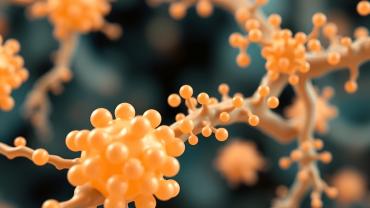
What is Tri-Butyrin?
Butyrate is a short-chain fatty acid (SCFA) that plays an integral role in gut health, supporting colon and mucosal health by nourishing colonocytes and promoting gut barrier integrity. Colonocytes absorb and metabolize butyrate for energy, which fuels vital functions like electrolyte transport and intestinal barrier maintenance. Additionally, butyrate promotes intestinal barrier integrity by supporting tight junctions and the mucus layer. Butyrate also promotes gastrointestinal (GI) regularity by enhancing colonic motility and maintaining gut homeostasis. Finally, butyrate may also promote a healthy GI microbial diversity by lowering the pH in the colon, which supports beneficial butyrate-producing bacteria while reducing the growth of opportunistic and potentially harmful species.
Tri-butyrin is a compound made out of three butyrate molecules bound to a glycerol backbone. This form of butyrate may increase its likelihood to reach the colon, where it can be optimally utilized by the colonocytes and support GI health. Tri-butyrin is hydrolyzed by the enzyme lipase in the GI tract, releasing butyrate and glycerol. In animal models, tri-butyrin has shown higher plasma butyrate levels, more favorable pharmacokinetics, and lower toxicity than sodium butyrate administration.
Experimental pre-clinical evidence suggests that tri-butyrin may play a role in supporting GI microbiome health and diversity. In a pre-clinical animal model, it promoted beneficial bacteria like Muribaculaceae, Bifidobacterium, and Parabacteroides and mitigated opportunistic bacteria like Bacteroides, Enterococcus, and Alloprevotella. It also supported SCFA status, healthy inflammatory responses, and intestinal barrier integrity by increasing goblet cells and MUC2 expression and tight junction proteins, such as zonula occludens-1 (ZO-1) and occludin. Pre-clinically, tri-butyrin has also been shown to support cardiovascular health and healthy body composition by promoting normal inflammatory responses and blood sugar and lipid metabolism, potentially via its action on the G protein-coupled receptor GPR109A.
What is Anaerostipes?
Anaerostipes is a genus of bacteria naturally found within the gut microbiome that plays an important role in GI and digestive health. Anaerostipes caccae (A. caccae) was originally isolated and designated as the type species (meaning first and defining member) of its genus in 2002. It is capable of fermenting carbohydrates, acetate, and lactate to produce butyrate, which is vital for gut barrier integrity, microbiome diversity, and healthy immune and inflammatory responses. Anaerostipes is part of the Bacillota (formerly Firmicutes) phylum and the Clostridium coccoides group (also known as Clostridium cluster XIVa), which is known for supporting butyrate production, gut health, and host immune health.
Experimental studies have demonstrated that A. caccae administration increases butyrate levels in the GI tract, supporting gut health and mitigating anaphylactic responses. In mouse models of milk and peanut allergy, A. caccae (alone or with lactulose) increased luminal butyrate status and mitigated allergic responses by enhancing gut barrier integrity, promoting regulatory T-cells, and lowering markers of inflammation and allergy. A controlled study with non-obese diabetic mice showed that colonization with a consortium of early-life commensal bacteria, including Anaerostipes, significantly reduced the incidence of diabetes.
Further clinical research in the form of randomized controlled human trials is needed; however, current pre-clinical findings position A. caccae as a key player in the direct production of butyrate in the lower GI tract, with important implications for gut health, microbial diversity, and overall host well-being.
The Interplay of Tri-Butyrin and Anaerostipes
Tri-butyrin and Anaerostipes are two methods of butyrate delivery to the lower GI tract. Both have been shown to support butyrate status, which plays an important role in gut health. Tri-butyrin is a triglyceride that can be synthetically derived or found in dietary sources. It delivers butyrate when hydrolyzed by the enzyme lipase, releasing butyrate and glycerol in the GI tract. Anaerostipes, on the other hand, is a butyrate-producing gut bacterium, which naturally inhabits a healthy human microbiome and delivers butyrate by metabolizing dietary carbohydrates, lactate, and acetate.
From a pharmacokinetic perspective, tri-butyrin is a precursor compound of butyrate, meaning that it is pharmacologically inactive when administered but becomes active after it is metabolized inside the body. On the other hand, Anaerostipes, present in the gut microbiome or supplemented in the form of a probiotic, actively produces butyrate under the anaerobic conditions of the colon. In cases where A. caccae may be depleted in the GI microbiome (for example, due to antibiotic use, low-fiber diet, or dysbiosis), tri-butyrin may help promote GI health and microbiome diversity. When microbiome health is supported, A. caccae may offer an endogenous source of butyrate production.
There seems to be an important synergy between butyrate and Anaerostipes, which may create a positive feedback loop. Members of the genus Anaerostipes are key butyrate-producing bacteria in the human GI tract, promoting a healthy butyrate status. At the same time, butyrate supports a more anaerobic environment in the colon, which favors Anaerostipes and other commensal anaerobes, while deterring the growth of opportunistic bacteria. Healthy butyrate status may also promote mucus production and thus support other keystone species, like the mucin-degrading bacteria Akkermansia muciniphila (A. muciniphila). A. caccae has been shown to ferment mucin-derived sugars such as glucose, mannose, galactose, and N-acetylgalactosamine, made by A. muciniphila, to produce more butyrate. This positive feedback loop between butyrate and Anaerostipes underscores the importance of the collective and potentially synergistic role of tri-butyrin and Anaerostipes in supporting gut health and butyrate status in the lower GI tract.
Learn more about butyrate, Anaerostipes, and gut health:
Two Next-Generation Probiotics You Should Know About: Anaerostipes and Akkermansia
Fueling the Gut: How Anaerostipes Caccae Powers Butyrate Production
The 5R Blueprint for Gut Health
Can Short-Chain Fatty Acids Elevate Your Exercise Routine?
By Antonia Toupet, PhD